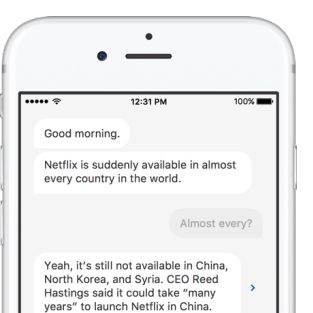
Quartz, The Atlantic–affiliated business-news publication, just launched a clever new iPhone news app, described in its announcement as “an ongoing conversation about the news, sort of like texting.” Its stories, written in conversational, emoji-laden English, are delivered to users like text messages; when you open one up, it’s presented as a speech bubble to which you can respond.
Quartz’s won’t be the last conversational news app or interface we see this year. The BBC’s Trushar Barot has predicted “the botification of news,” mentioning chat bots specifically. The New York Times just released an election bot that integrates with the enterprise chat software Slack; not only does it automatically deliver news and results about the presidential elections to an integrated chat room, but users can ask the bot questions that will be forwarded, it claims, to the Times’ election desk.
News is well suited for bots that can express themselves in natural language (in other words: bots that can write), but in most ways the publishing industry is just following its peers elsewhere in tech: Quartz’s app and the Times’ bot are part of a growing trend in software whose main interface is conversation (or conversational) — software that acts like a personal digital assistant, like Siri, or Microsoft’s Cortana. Instead of knowing exactly which buttons to push and menus to click to get what you want, you can now (or soon) just ask a computer using natural language.
What’s interesting about this, particularly for media, is that software alone isn’t quite up to the task yet (and may never be) — so humans are forced to become a part of the “bot” experience. What you interact with isn’t necessarily a bot or a human, but a mix of both. Customer service was a proving ground for this a few years ago. Have you ever visited a website and immediately encountered a customer service pop-up asking if you need help? The odds are pretty good that if you use it, you’ll start the conversation with a bot and, somewhere within the process, quietly transition to a human operator.
Sometimes, this is happening along vectors that you don’t even notice. Bots are responsible for churning out automated articles on data-heavy topics — things like corporate earnings and … earthquakes. But for more, well, human topics, the question of how information is presented to users is less certain. Facebook’s Trending Topics are the best example of this — the process of exactly who (or what) curates them is unclear, and what results is a stilted mash of automated input and extraction and creative human knowledge.
On the flip side of Facebook’s detached list is Quartz’s new app. Its tone is resolutely, almost aggressively human (it’s written by a team of editors), but there are simulated touches that drive it into the uncanny valley. In particular, the app, though it doesn’t need to, simulates the three-dot speech bubble that signifies someone is typing. The iconography is key here. When a smartphone (or at least an iPhone in this case) is transferring data, the standard indicator is that small spinning wheel in the status bar at the top of the screen. The three-dot bubble is different. It indicates, very clearly, another human is typing at the keyboard. This isn’t, on one hand, entirely wrong — a human did write what will soon arrive on your screen — but it’s also not right: No one is typing on the other end. Compellingly, eerily, and in a way that I would not be surprised to see catch on, Quartz is equating downloading data with actual human interaction.
It’s still fairly easy to tell when you’re talking to a computer (spinning wheel), or a human (floating dots). But it’s getting harder not simply because humans are increasingly reliant on algorithmic input, or because software is getting better at mimicking human behavior, but because the things we interact with tend to involve both human and bot input at multiple levels of operation. We have humans mimicking the cold, to-the-point news presentation of algorithms like Facebook’s, and bots mimicking the folksy, “brands saying ‘bae’” tone of our modern media economy. What comes out the other end is less a bot that sounds like a human, or a human that sounds like a bot, than an uncanny hybrid.





























